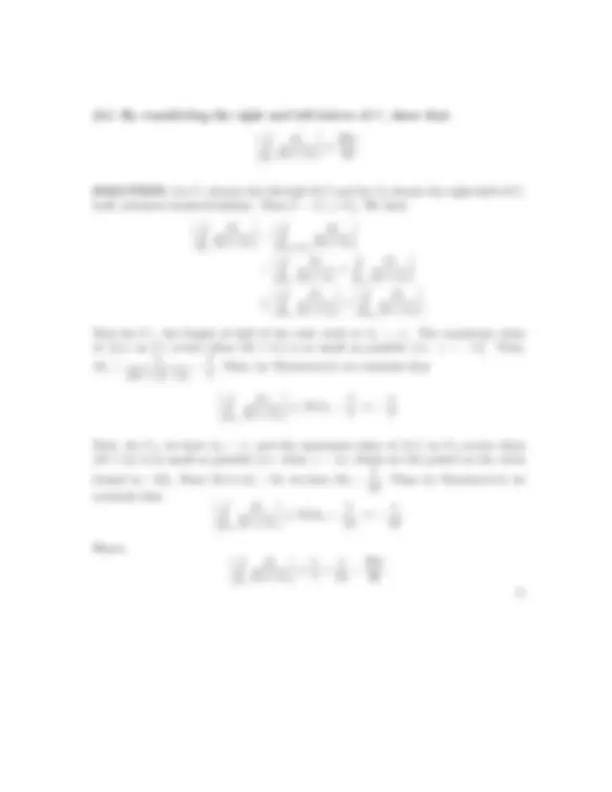



Study with the several resources on Docsity

Earn points by helping other students or get them with a premium plan


Prepare for your exams
Study with the several resources on Docsity

Earn points to download
Earn points by helping other students or get them with a premium plan
Community
Ask the community for help and clear up your study doubts
Discover the best universities in your country according to Docsity users
Free resources
Download our free guides on studying techniques, anxiety management strategies, and thesis advice from Docsity tutors
The solutions for problem 1 and problem 2 of math 412 group work #13. Problem 1 involves evaluating the complex integral c x dz from −4 to 4 along the upper half of the circle |z| = 4, while problem 2 requires showing that the integral dz (12 + 5z) for the unit circle c is less than or equal to 20π. The solutions are based on parametrization, theorem 6.3, and the length of the contour.
Typology: Assignments
1 / 2

This page cannot be seen from the preview
Don't miss anything!


Math 412 Group Work #13 Spring 2009
SOLUTIONS
Problem 1. Evaluate
C
x dz from − 4 to 4 along the upper half of the circle
|z| = 4, oriented clockwise.
SOLUTION: If we parametrize C via z(t) = (4 cos t) − i(4 sin t), where −π ≤ t ≤ 0,
then z
′ (t) = (−4 sin t) − i(4 cos t) and dz = [(−4 sin t) − i(4 cos t)]dt. Hence,
C
x dz =
−π
(4 cos t)[(−4 sin t) − i(4 cos t)]dt
−π
−16 sin t cos t − i(16 cos
2 t)
dt
∫ (^) −π
0
16 sin t cos t + i(16 cos
2 t)
dt
= 16i
π
0
cos
2 t dt
= 16i ·
π
= 8πi.
Problem 2. Let C be the unit circle in the complex plane, oriented coun-
terclockwise.
(a): Show that ∣ ∣ ∣ ∣
C
dz
12 + 5z
2 π
SOLUTION: We wish to apply Theorem 6.3. Since the circumference of the unit
circle is 2π, the length of the contour C is L = 2π. The maximum value of f (z) =
1
12 + 5z
occurs when |12 + 5z| is as small as possible (i.e. when z = −1). Thus,
. Thus, by Theorem 6.3, we conclude that
C
dz
12 + 5z
· 2 π =
2 π
(b): By considering the right and left halves of C, show that
∣ ∣ ∣ ∣
C
dz
12 + 5z
20 π
SOLUTION: Let C 1 denote the left-half of C and let C 2 denote the right-half of C,
both oriented counterclockwise. Then C = C 1 + C 2. We have
∣ ∣ ∣ ∣
C
dz
12 + 5z
C 1 +C 2
dz
12 + 5z
C 1
dz
12 + 5z
C 2
dz
12 + 5z
C 1
dz
12 + 5z
C 2
dz
12 + 5z
Now for C 1 , the length of half of the unit circle is L 1 = π. The maximum value
of f (z) on C 1 occurs when |12 + 5z| is as small as possible (i.e. z = −1). Thus,
. Thus, by Theorem 6.3, we conclude that
C 1
dz
12 + 5z
· π =
π
Next, for C 2 , we have L 2 = π, and the maximum value of f (z) on C 2 occurs when
|12 + 5z| is as small as possible (i.e. when z = ±i, which are the points on the circle
closest to −12). Since | 12 ± 5 i| = 13, we have M 2 =
. Thus, by Theorem 6.3, we
conclude that (^) ∣ ∣ ∣ ∣
C 2
dz
12 + 5z
· π =
π
Hence, ∣ ∣ ∣ ∣
C
dz
12 + 5z
π
π
20 π